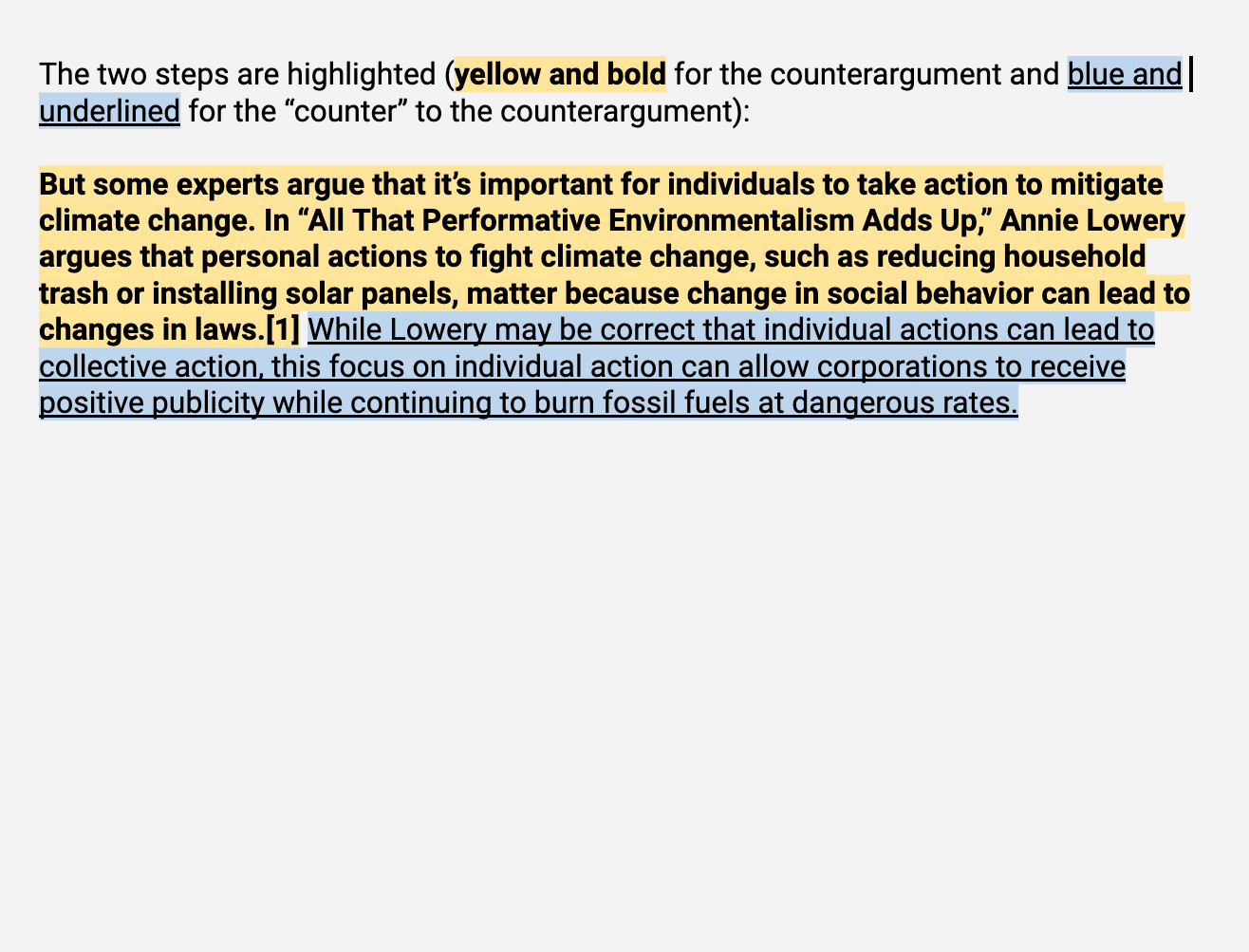Consider the following thesis for a short paper that analyzes different approaches to stopping climate change:
Climate activism that focuses on personal actions such as recycling obscures the need for systemic change that will be required to slow carbon emissions.
The author of this thesis is promising to make the case that personal actions not only will not solve the climate problem but may actually make the problem more difficult to solve. In order to make a convincing argument, the author will need to consider how thoughtful people might disagree with this claim. In this case, the author might anticipate the following counterarguments:
- By encouraging personal actions, climate activists may raise awareness of the problem and encourage people to support larger systemic change.
- Personal actions on a global level would actually make a difference.
- Personal actions may not make a difference, but they will not obscure the need for systemic solutions.
- Personal actions cannot be put into one category and must be differentiated.
In order to make a convincing argument, the author of this essay may need to address these potential counterarguments. But you don’t need to address every possible counterargument. Rather, you should engage counterarguments when doing so allows you to strengthen your own argument by explaining how it holds up in relation to other arguments.

How to address counterarguments
Once you have considered the potential counterarguments, you will need to figure out how to address them in your essay. In general, to address a counterargument, you’ll need to take the following steps.
- State the counterargument and explain why a reasonable reader could raise that counterargument.
- Counter the counterargument. How you grapple with a counterargument will depend on what you think it means for your argument. You may explain why your argument is still convincing, even in light of this other position. You may point to a flaw in the counterargument. You may concede that the counterargument gets something right but then explain why it does not undermine your argument. You may explain why the counterargument is not relevant. You may refine your own argument in response to the counterargument.
- Consider the language you are using to address the counterargument. Words like but or however signal to the reader that you are refuting the counterargument. Words like nevertheless or still signal to the reader that your argument is not diminished by the counterargument.
Here’s an example of a paragraph in which a counterargument is raised and addressed.

Image version

The two steps are marked with counterargument and “counter” to the counterargument: COUNTERARGUMENT/ But some experts argue that it’s important for individuals to take action to mitigate climate change. In “All That Performative Environmentalism Adds Up,” Annie Lowery argues that personal actions to fight climate change, such as reducing household trash or installing solar panels, matter because change in social behavior can lead to changes in laws. [1]
COUNTER TO THE COUNTERARGUMENT/ While Lowery may be correct that individual actions can lead to collective action, this focus on individual action can allow corporations to receive positive publicity while continuing to burn fossil fuels at dangerous rates.
Where to address counterarguments
There is no one right place for a counterargument—where you raise a particular counterargument will depend on how it fits in with the rest of your argument. The most common spots are the following:
- Before your conclusion This is a common and effective spot for a counterargument because it’s a chance to address anything that you think a reader might still be concerned about after you’ve made your main argument. Don’t put a counterargument in your conclusion, however. At that point, you won’t have the space to address it, and readers may come away confused—or less convinced by your argument.
- Before your thesis Often, your thesis will actually be a counterargument to someone else’s argument. In other words, you will be making your argument because someone else has made an argument that you disagree with. In those cases, you may want to offer that counterargument before you state your thesis to show your readers what’s at stake—someone else has made an unconvincing argument, and you are now going to make a better one.
- After your introduction In some cases, you may want to respond to a counterargument early in your essay, before you get too far into your argument. This is a good option when you think readers may need to understand why the counterargument is not as strong as your argument before you can even launch your own ideas. You might do this in the paragraph right after your thesis.
- Anywhere that makes sense As you draft an essay, you should always keep your readers in mind and think about where a thoughtful reader might disagree with you or raise an objection to an assertion or interpretation of evidence that you are offering. In those spots, you can introduce that potential objection and explain why it does not change your argument. If you think it does affect your argument, you can acknowledge that and explain why your argument is still strong.
[1] Annie Lowery, “All that Performative Environmentalism Adds Up.” The Atlantic . August 31, 2020. https://www.theatlantic.com/ideas/archive/2020/08/your-tote-bag-can-mak…
- picture_as_pdf Counterargument

COMMENTS
The most common spots are the following: Before your conclusion. This is a common and effective spot for a counterargument because it’s a chance to address anything that you think a reader might still be concerned about after you’ve made your main argument. Don’t put a counterargument in your conclusion, however.